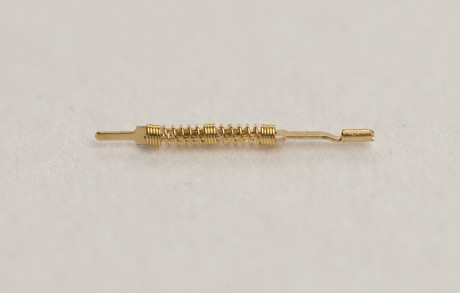A new breed of spring-loaded pin
Wednesday, 08 February, 2017

Connector manufacturers are turning to more affordable H-Pins over traditional pogo-style options without sacrificing performance.
For decades, connector manufacturers have relied on traditional spring-loaded, or pogo-style, pins to provide highly compliant, reliable interconnections. Although expensive, these highly compliant pins are used to connect batteries to docking stations and antennas to PCBs; for rugged, high-shock and vibration applications; or to compensate for floating heights and uneven mating surfaces.
However, with the market drive to continually pack more electronics into ever thinner, shrinking packages, spring-loaded connectors are playing a new role: as a space-saving device to reduce the real estate occupied by the connector itself.
Even when miniaturised, connectors with traditional male pins and female receptacles take up valuable space. This is opening the door for compression-style board-to-board and board-to-device connectors that utilise spring-loaded pins mounted against pads or gold-plated lands on the PCB. This approach can be used to create mezzanine-tiered board modules as well.
The trouble is, with hundreds of millions of spring-loaded pins required to produce these connectors, the high cost of traditional pogo-style pins remains a considerable barrier.
As a result, connector manufacturers are turning to a new breed of miniaturised spring-loaded pins as small as 0.2 mm that reduces costs by 30–50%. These pins deliver high performance in a highly compliant contact that — unlike pogo-style pins — is manufactured in a fully automated, high-speed production process.
Pogo-style pins
For decades the spring-loaded probe, also known as the pogo-style pin, has delivered excellent mechanical and electrical performance. However, this often came at a high cost.
Although designed and manufactured in subtly different ways, the pogo-style pin is typically constructed of 4–5 components that include a drawn barrel, a wound spring, two screw machined plungers and some means to bias the plunger to the barrel.
Depending on volume, the traditional pogo pin is either assembled completely by hand or with semiautomatic process steps with pins hand-shuttled from process to process. As a result, the market stopped using pogo pins for all applications other than the most critical applications that could afford the premium costs.
Instead, many connector manufacturers turned to alternatives such as bend, buckle or cantilever-style contacts that require additional space between pins during compression. However, this approach is not viable for fine pitch applications — defined as the number of pins in a small area or the distance between pin centres — required for today’s high-density electronics.
Spring-loaded pins, on the other hand, operate in a purely vertical or horizontal fashion, so the maximum space occupied at any time is defined by its diameter. This allows for placement of spring-loaded pins in fine pitch distances as low as 0.2 mm.
H-Pins
The H-Pin, on the other hand, is made using two stamped contact beams (sometimes symmetrical) and a wound spring in a fully automated, high-speed assembly and inspection process.
The highly compliant pin has a working range up to 1 mm with a flat spring rate and can be utilised up to 15 GHz with -1 dB loss, carry up to 4 A of current and withstand temperatures up to 200°C.

However, it is the way these pins are manufactured that is the most striking difference. Whereas traditional pogo-style pins are produced in a semiautomated process at the rate of 200–600 per hour, the completely automated stamping process that produces the H-Pin can produce 200–600 per minute.
By automating the process, the spring-loaded probe pins can cost 30–50% less, depending on quantities. Reducing the number of components also increases reliability.
Available in various lengths and pitch sizes as low as 0.2 mm, H-Pins are the brainchild of Plastronics, which uses spring-loaded probe pins — including pogo-style pins — in the test socket industry. Test sockets utilise spring-loaded pins to provide a temporary connection with PCBs for the purposes of burn-in, humidity, failure analysis and other test requirements.
Plastronics embarked on a mission to redesign the pins and reinvent the manufacturing process so it was fully automated. The goal was to provide a highly compliant pin that provides high temperature, current and bandwidth performance at the price of a stamped contact.

The company also inspects each stamped contact at multiple steps in the process to ensure the pins are identical. The spring winding process is controlled by wire diameter and spring OD is 100% inspected during spring winding. All components are auto-inspected as they enter the assembly machine. Finally, all finished parts are auto-inspected before leaving the machine.
With the market driving demand for increasingly miniaturised, fine-pitch pins in the hundreds of millions, the high-speed, fully automated production of this new breed of pin is expected to have major implications on cost, delivery and reliability.
You are here
The benefits of using cellular services and Wi-Fi to keep track of valuable goods.
A game changer for building robust distributed systems
Researchers have developed a new distributed algorithm that solves one of the key performance and...
A guide to implementing remote monitoring
Remote monitoring enables people and companies to collect data from locations where conventional...





